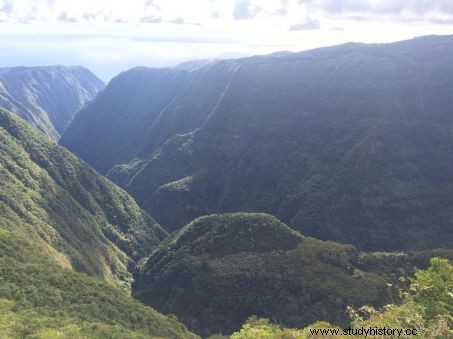In the middle of the 19th century, several thousand children experienced forced labor in the penal colony of Îlet à Guillaume, perched 700 meters above sea level on a plateau on the island of Reunion. Today, archaeological excavations are being carried out on the site in an attempt to uncover their painful history.

A sketch from 1871 representing "Îlette à Guillaume and the community of Neuville".
Hikers familiar with the reliefs of Reunion are familiar with these old stone walls covered with moss, a two-hour walk from Saint-Denis. But many are unaware that they are the vestiges of a sad past that dates back more than 150 years. Listed as historical monuments since 2008, once abandoned as a cache for escaped slaves, this site, even in ruins, testifies to the harshness of a time when even the youngest did not escape prison.
Hikers familiar with the reliefs of Reunion are familiar with these old stone walls covered with moss, a two-hour walk from Saint-Denis. But many are unaware that they are the vestiges of a sad past that dates back more than 150 years. Listed as a historical monument since 2008, this site, even in ruins, testifies to the harshness of a time when even the youngest did not escape prison.
From 1864 to 1879, the Îlet à Guillaume penal colony received more than 3,000 children. Under the rule of the missionaries of the Congregation of the Holy Spirit, or Spiritans, they worked tirelessly to "recover", according to the term of the time. For 15 years, their still frail arms cut and carried stones, built buildings, cultivated the land, managed the barnyard, forged, sawed, and also prayed.

The preserved elevations of the temporary chapel, one of the few masonry walls on the site. Credits:Inrap
"Natural" prison
In October 2020, as part of the Reunion Department's development of this little-known place, a team from the National Institute for Preventive Archaeological Research (Inrap) carried out excavations on the site, the history of which is already the subject of several publications. But no archaeological study of the ruins had so far been undertaken. Today, their study focuses on understanding the organization of the penitentiary and the way the children built it with their hands. Chronology of the buildings, photogrammetric survey of all the elevations and levels, archaeo-botanical analysis... The experts should now know a little more about the exhausting daily life of these forgotten little ones.

A view of the Îlet from the west, where you can see in the foreground the wooded plateau bounded by the Bras Guillaume. The "ramparts" naturally isolated the penitentiary. Credits:Inrap
In this prison which did not need bars nor walls, so much its access, cut in the wall with precipice dominating the river of Saint-Denis, was perilous, the youngest prisoner was 7 years old, when the majority were not still only teenagers. Young people almost all descendants of freed African slaves, sent to this perched jungle for petty theft, rebellious behavior or even for vagrancy. Doomed for not having a roof to sleep under every night… Sometimes one or two white people would join them. Judged as "lost causes", no doubt.
Condemned to silence and oblivion
Once outside and adults, when they did not return directly to an adult prison, they did not testify to their stay on Îlet à Guillaume. In fact, only the archives of the congregation remain of the practices in force at Îlet à Guillaume – archives from which were taken moving photos of the little workers, shovel in hand. There is no doubt, however, that the living conditions imposed by the fathers must have been excessively difficult there, the punishments severe and the abuses legion. The small cemetery located out of the way, where lie a dozen unnamed graves, speaks for itself. Only circles of stones indicate that bodies are here, underground. The stones of their labor and of their final resting place, therefore.

A photograph of children working in the road section and supervised by Brother Isaac in 1868. Credits:Collection of the Congregation of the Holy Spirit
In the history of French incarceration, the "bagnes d'enfants" remain relatively confidential. It is above all to avoid sending the youngest to traditional prisons that they were established under the law of August 5, 1850 on the education of minor prisoners. The most famous is the public maritime and agricultural penal colony of Belle-Île-en-Mer, created in 1880. That of Aniane, founded in 1886 in Hérault, is also remembered for having been the one of the strictest in the country. It will not close its doors until 1937. The only agricultural penal colony of Îlet à Guillaume, it is the only one that has emerged in Reunion. It will be closed definitively in 1879, at a time when the colony of Reunion, which has become secular and republican, no longer wants the clergy to manage these establishments.
